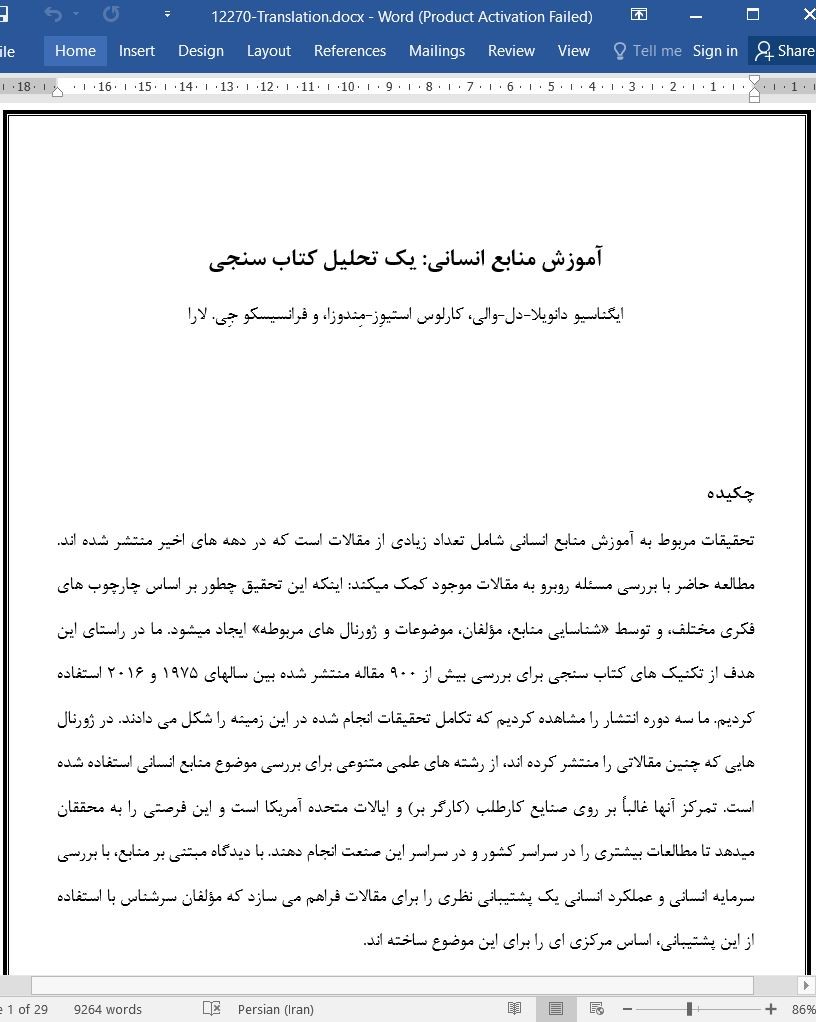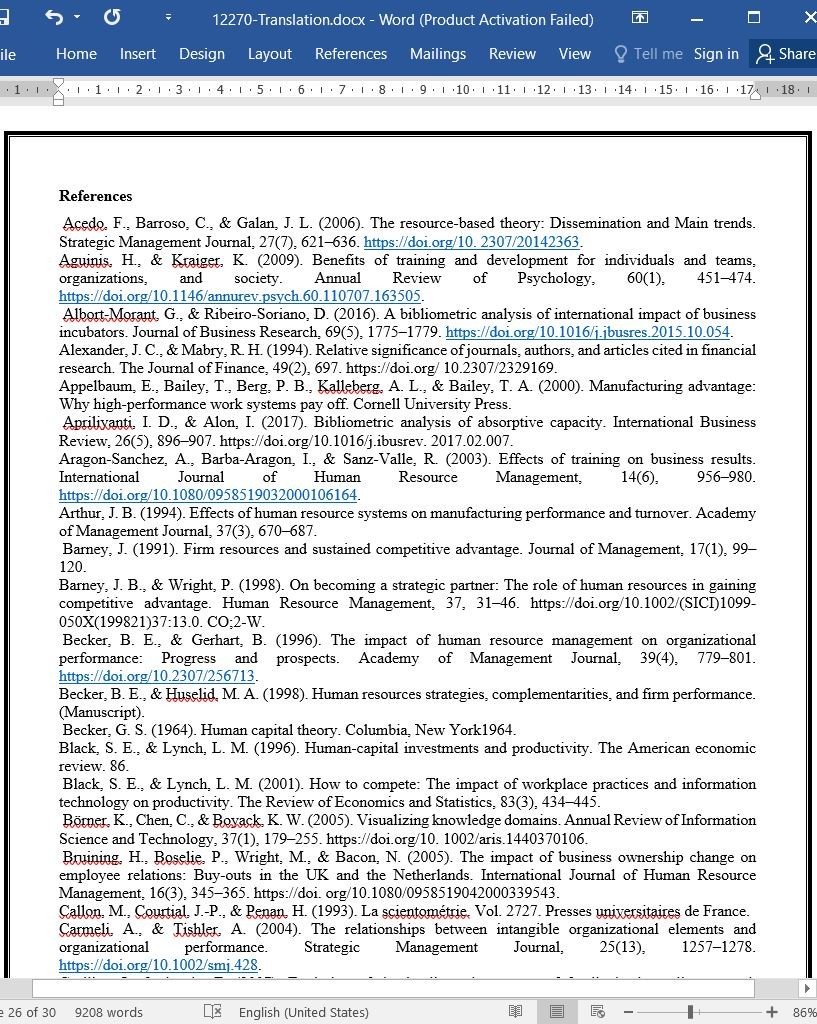
آموزش منابع انسانی: یک تحلیل کتاب سنجی
چکیده
تحقیقات مربوط به آموزش منابع انسانی شامل تعداد زیادی از مقالات است که در دهه های اخیر منتشر شده اند. مطالعه حاضر با بررسی مسئله روبرو به مقالات موجود کمک میکند: اینکه این تحقیق چطور بر اساس چارچوب های فکری مختلف، و توسط «شناسایی منابع، مؤلفان، موضوعات و ژورنال های مربوطه» ایجاد میشود. ما در راستای این هدف از تکنیک های کتاب سنجی برای بررسی بیش از 900 مقاله منتشر شده بین سالهای 1975 و 2016 استفاده کردیم. ما سه دوره انتشار را مشاهده کردیم که تکامل تحقیقات انجام شده در این زمینه را شکل می دادند. در ژورنال هایی که چنین مقالاتی را منتشر کرده اند، از رشته های علمی متنوعی برای بررسی موضوع منابع انسانی استفاده شده است. تمرکز آنها غالباً بر روی صنایع کارطلب (کارگر بر) و ایالات متحده آمریکا است و این فرصتی را به محققان میدهد تا مطالعات بیشتری را در سراسر کشور و در سراسر این صنعت انجام دهند. با دیدگاه مبتنی بر منابع، با بررسی سرمایه انسانی و عملکرد انسانی یک پشتیبانی نظری را برای مقالات فراهم می سازد که مؤلفان سرشناس با استفاده از این پشتیبانی، اساس مرکزی ای را برای این موضوع ساخته اند.
1. مقدمه
در چند دهه گذشته، پیشرفت تکنولوژیکی و تکامل بازار، بسیاری از کشورها را واداشته است که استراتژی هایشان را از نو طراحی کنند. بسیاری از مطالعات بیان کرده اند که منابع ناملموس میتوانند مزایای رقابتی ای را در این زمینه ایجاد کرده باشند (گالبریت 2005؛ هال 1992، 1993؛ لیم، چان و دالیمور 2010؛ ویلا لانگا 2004). اتفاق نظری در رابطه با دارائی های ناملموس مربوط به منابع انسانی وجود دارد؛ این دارائی ها در گروه سرمایه انسانی جای می گیرند و از جمله بهترین عناصر توضیحی برای مطالعه بهبودهای انجام شده در عملکرد شرکت ها است (کارملی و تیشلر 2004؛ ادمانس 2011؛ هچ و دایر 2004؛ لیو، وان جارزوِلد، بَت و فراست 2014؛ مارتین-دی-کاسترو، دلگادو-وِردی، لوپز-سائز و ناواس-لوپز 2011؛ رانگون 1999؛ ویلا لانگا 2004).
5.1 محدودیت ها، و پیشنهاداتی برای تحقیقات آینده
مطالعه ما محدودیت هایی هم دارد. اگرچه ما کمک هایی را برای کل دوره مطالعه بررسی کردیم، اما انجام همین نوع تحلیل برای هر یک از مراحل شناسایی شده هم سودمند خواهد بود. اینکار میتواند منجر به دیدگاه متفاوتی در مورد تکامل شاخص ها گردد و راه مختلفی را برای درک روندهای ممکن ارائه نماید.
در خصوص مکان یابی منابع ذکر شده، بهتر است از برنامه نویسی زبان طبیعی دقیقی (زمانیکه در دسترس باشد) استفاده شود تا نتایج معناداری را به این تکنیک ها اضافه نماید.
تحقیقات آینده در مورد آموزش منابع انسانی می توانند بر پر کردن شکاف هایی تمرکز کنند که توسط ما شناسایی شده است. همچنین کسب بینش های بیشتر در دامنه وسیع تری از صنایع و انجام تحلیل های بیشتر از یک دیدگاه بین المللی نیز سودمند خواهد بود. در نهایت، ما فکر می کنیم که کمک (مطالعه) ما یک مبنای چاره جو را برای توسعه فراتحلیل هایی درباره این موضوع، فراهم می سازد.
Abstract
Research on human resources training has been shaped by a great number of articles published in recent decades. This study contributes to the literature by examining how this research is built on the basis of different intellectual frameworks and by identifying the relevant references, authors, topics, and journals. With this aim, we used bibliometric techniques to examine over 900 articles published between 1975 and 2016. We observed three publication periods that have shaped the evolution of research in this field. In the journals that have published these articles, a wide range of disciplines have been used to address the topic of human resources. The dominant focus is on US and labor-intensive industries, giving researchers the opportunity to undertake further cross-country and cross-industry studies. By considering human capital and performance, the resource-based view provides theoretical support for the articles through which leading authors have built a core grounding for the topic.
1. Introduction
Over the last few decades, technological progress and market evolution have led many companies to redesign their strategies. Many studies state that intangible resources might have provided sustainable competitive advantages in this context (Galbreath, 2005; Hall, 1992, 1993; Lim, Chan, & Dallimore, 2010; Villalonga, 2004). There is some consensus in considering human resources-related intangible assets, grouped as human capital, to be among the best explanatory elements for studying improvements in company performance (Carmeli & Tishler, 2004; Edmans, 2011; Hatch & Dyer, 2004; Liu, van Jaarsveld, Batt, & Frost, 2014; Martín-de-Castro, Delgado-Verde, López-Sáez, & Navas-López, 2011; Rangone, 1999; Villalonga, 2004).
5.1. Limitations and future research
Our study has certain limitations. Although we examined contributions for the whole study period, it may be helpful to perform the same type of analysis for each of the stages identified. This could provide a different perspective on the evolution of indicators and offer a different way to understand possible trends.
As regards the placement of cited references, it would be interesting to use accurate natural language programming, once it becomes available, in order to add meaningful results to these techniques.
Future research on human resources training could aim to fill some of the gaps we highlight. It would be interesting to gain further insights into a broader range of industries and to perform more analyses from an international perspective. Finally, we think that our contribution provides a resourceful foundation on which to develop meta-analyses on this topic.
چکیده
1. مقدمه
2. مروری برای مقالات مربوط به کتاب سنجی
3. روش شناسی
3.1 واحد تحلیل
3.2 منبع یابی و مدیریت پایگاه داده
3.3 شاخص ها و تجسم نتایج (به شکل تصویر)
3.4 فرآیند تحلیل داده
4. نتایج
4.1 مقالات منتشر شده در هر سال
4.2 کشورها و زبان های نشریات
4.3 بهره وری ژورنال ها
4.4 بهره وری مؤلفان
4.5 تحلیل منابع
4.6 موضوعاتی در مورد آموزش منابع انسانی
5. نتیجه گیری ها
5.1 محدودیت ها، و پیشنهاداتی برای تحقیقات آینده
منابع
ABSTRACT
1. Introduction
2. Review of the literature on bibliometrics
3. Methodology
3.1. Unit of analysis
3.2. Database sourcing and management
3.3. Indicators and results visualization
3.4. Data analysis process
4. Results
4.1. Publications per year
4.2. Countries and languages of publications
4.3. Journal productivity
4.4. Authors' productivity
4.5. References analysis
4.6. Topics on human resources training
5. Conclusions
5.1. Limitations and future research
References
- اصل مقاله انگلیسی با فرمت ورد (word) با قابلیت ویرایش
- ترجمه فارسی مقاله با فرمت ورد (word) با قابلیت ویرایش، بدون آرم سایت ای ترجمه
- ترجمه فارسی مقاله با فرمت pdf، بدون آرم سایت ای ترجمه



